Architectural products company Apogee (NASDAQ:APOG) beat Wall Street’s revenue expectations in Q4 CY2024, but sales were flat year on year at $341.3 million. Its non-GAAP profit of $1.19 per share was 6.9% above analysts’ consensus estimates.
Is now the time to buy Apogee? Find out by accessing our full research report, it’s free.
Apogee (APOG) Q4 CY2024 Highlights:
- Revenue: $341.3 million vs analyst estimates of $332.2 million (flat year on year, 2.8% beat)
- Adjusted EPS: $1.19 vs analyst estimates of $1.11 (6.9% beat)
- Adjusted EBITDA: $45.8 million vs analyst estimates of $43.99 million (13.4% margin, 4.1% beat)
- Management reiterated its full-year Adjusted EPS guidance of $5.05 at the midpoint
- Operating Margin: 8.4%, down from 11.1% in the same quarter last year
- Free Cash Flow Margin: 6.4%, down from 16.1% in the same quarter last year
- Market Capitalization: $1.56 billion
Ty R. Silberhorn, Chief Executive Officer stated, “Our team remains focused on strengthening our operating foundation and positioning the company for long-term growth, despite continued pressure from soft demand in our end markets which is impacting results in the near term. During the quarter, we completed our acquisition of UW Solutions, expanding the capabilities and market opportunity in our LSO segment and creating a platform we expect to drive future growth.”
Company Overview
Involved in the design of the Apple Store on Fifth Avenue in New York City, Apogee (NASDAQ:APOG) sells architectural products and services such as high-performance glass for commercial buildings.
Commercial Building Products
Commercial building products companies, which often serve more complicated projects, can supplement their core business with higher-margin installation and consulting services revenues. More recently, advances to address labor availability and job site productivity have spurred innovation. Additionally, companies in the space that can produce more energy-efficient materials have opportunities to take share. However, these companies are at the whim of commercial construction volumes, which tend to be cyclical and can be impacted heavily by economic factors such as interest rates. Additionally, the costs of raw materials can be driven by a myriad of worldwide factors and greatly influence the profitability of commercial building products companies.
Sales Growth
A company’s long-term performance is an indicator of its overall quality. While any business can experience short-term success, top-performing ones enjoy sustained growth for years. Unfortunately, Apogee struggled to consistently increase demand as its $1.38 billion of sales for the trailing 12 months was close to its revenue five years ago. This was below our standards and is a sign of lacking business quality.
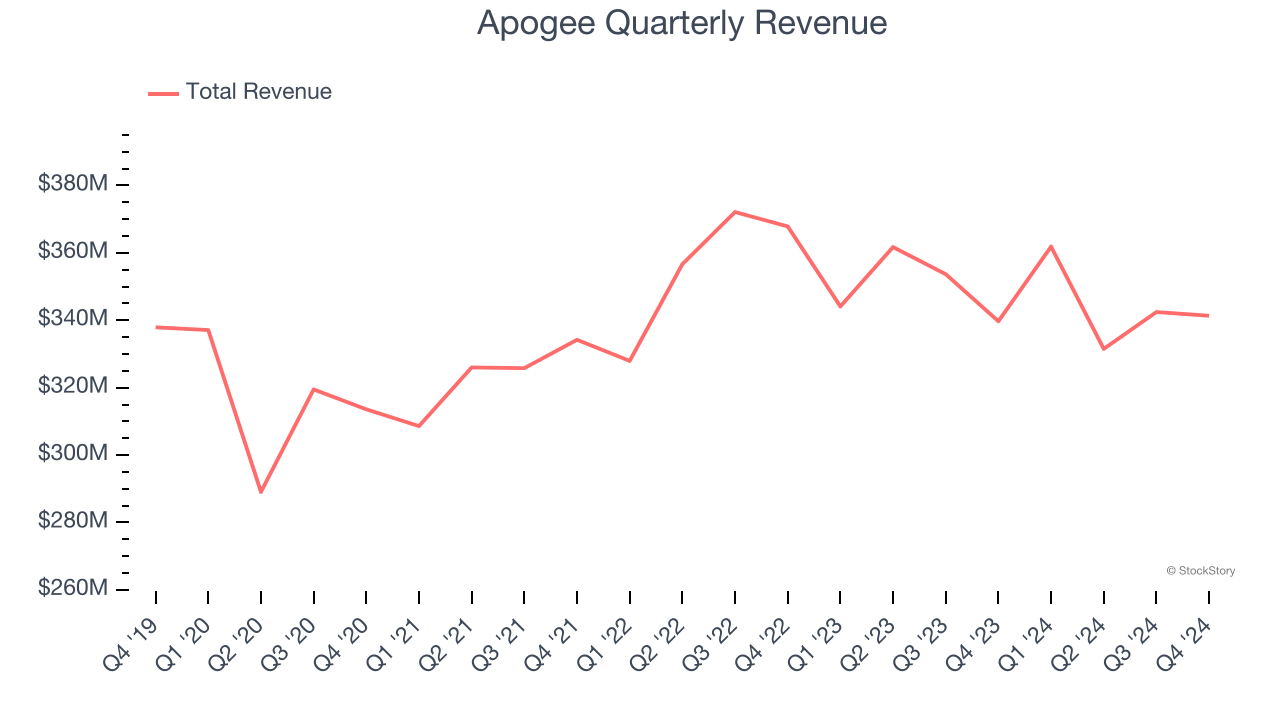
Long-term growth is the most important, but within industrials, a half-decade historical view may miss new industry trends or demand cycles. Apogee’s recent history shows its demand has stayed suppressed as its revenue has declined by 1.7% annually over the last two years. Apogee isn’t alone in its struggles as the Commercial Building Products industry experienced a cyclical downturn, with many similar businesses observing lower sales at this time. 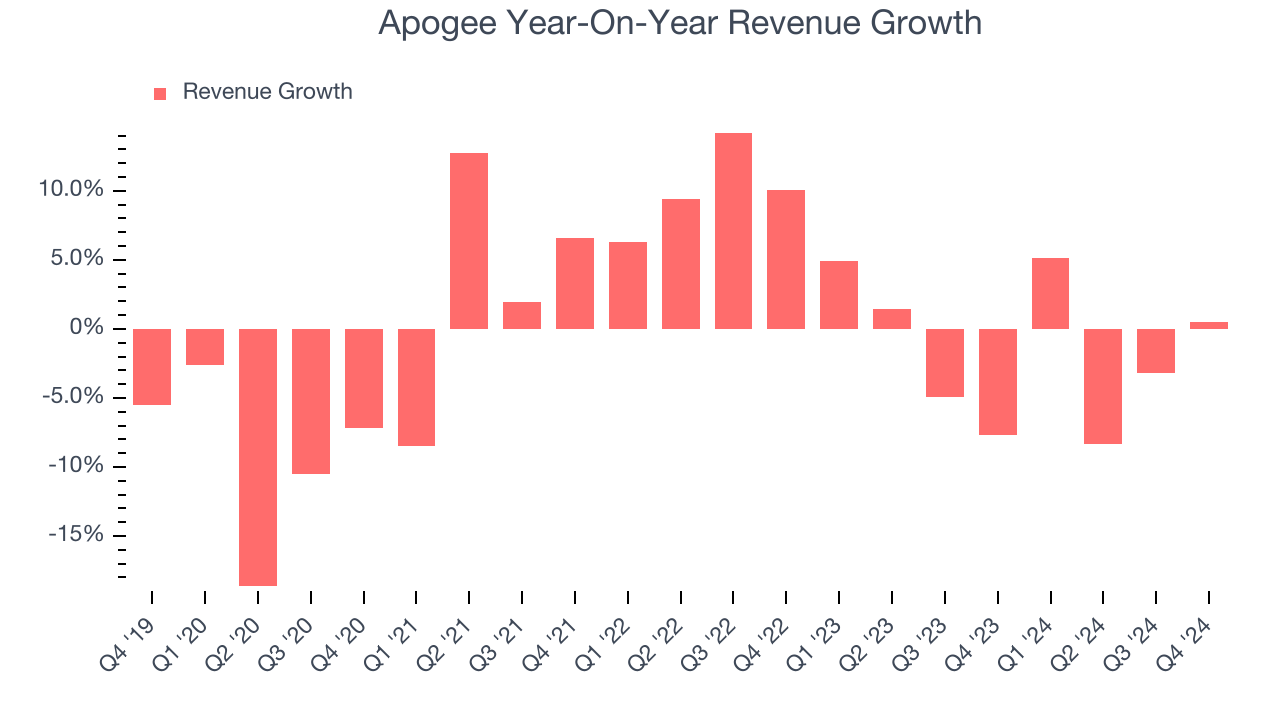
This quarter, Apogee’s $341.3 million of revenue was flat year on year but beat Wall Street’s estimates by 2.8%.
Looking ahead, sell-side analysts expect revenue to grow 4.9% over the next 12 months. Although this projection suggests its newer products and services will catalyze better top-line performance, it is still below the sector average.
Unless you’ve been living under a rock, it should be obvious by now that generative AI is going to have a huge impact on how large corporations do business. While Nvidia and AMD are trading close to all-time highs, we prefer a lesser-known (but still profitable) stock benefiting from the rise of AI. Click here to access our free report one of our favorites growth stories.
Operating Margin
Operating margin is one of the best measures of profitability because it tells us how much money a company takes home after procuring and manufacturing its products, marketing and selling those products, and most importantly, keeping them relevant through research and development.
Apogee has done a decent job managing its cost base over the last five years. The company has produced an average operating margin of 8.3%, higher than the broader industrials sector.
Analyzing the trend in its profitability, Apogee’s operating margin rose by 4.8 percentage points over the last five years, showing its efficiency has improved.
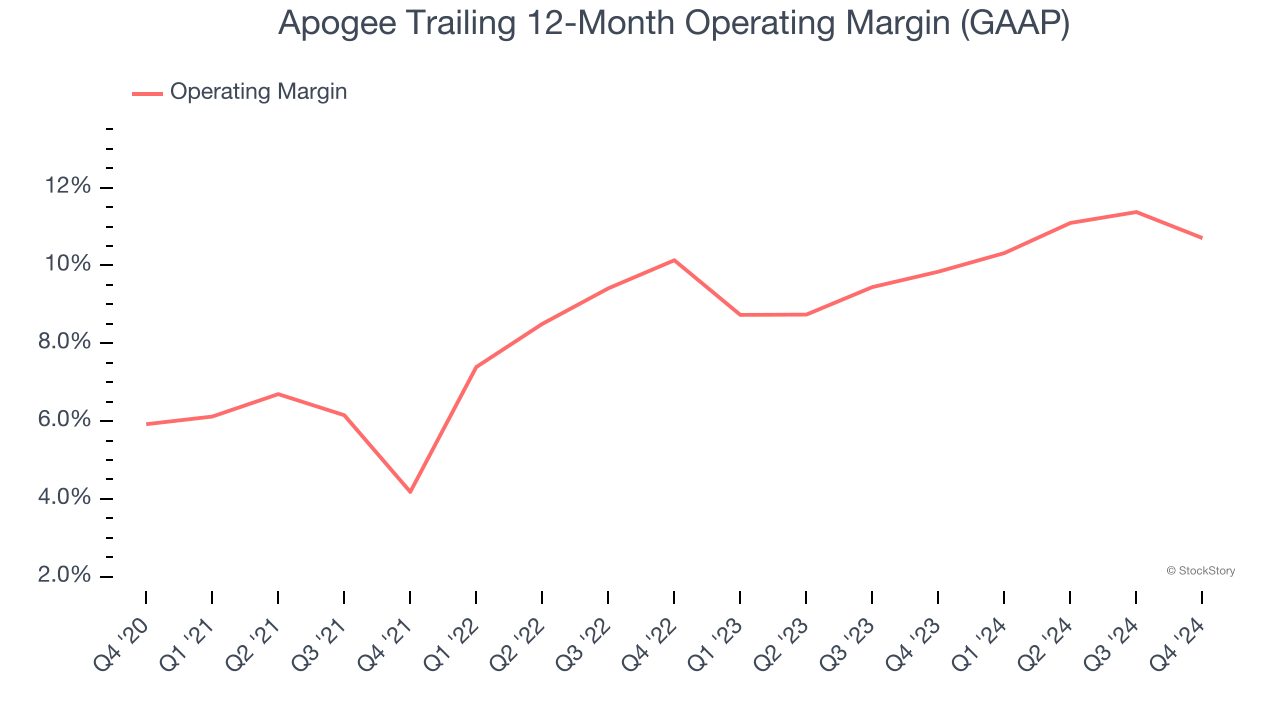
This quarter, Apogee generated an operating profit margin of 8.4%, down 2.7 percentage points year on year. Since Apogee’s operating margin decreased more than its gross margin, we can assume it was recently less efficient because expenses such as marketing, R&D, and administrative overhead increased.
Earnings Per Share
Revenue trends explain a company’s historical growth, but the long-term change in earnings per share (EPS) points to the profitability of that growth – for example, a company could inflate its sales through excessive spending on advertising and promotions.
Apogee’s EPS grew at a remarkable 13.9% compounded annual growth rate over the last five years, higher than its flat revenue. This tells us management responded to softer demand by adapting its cost structure.
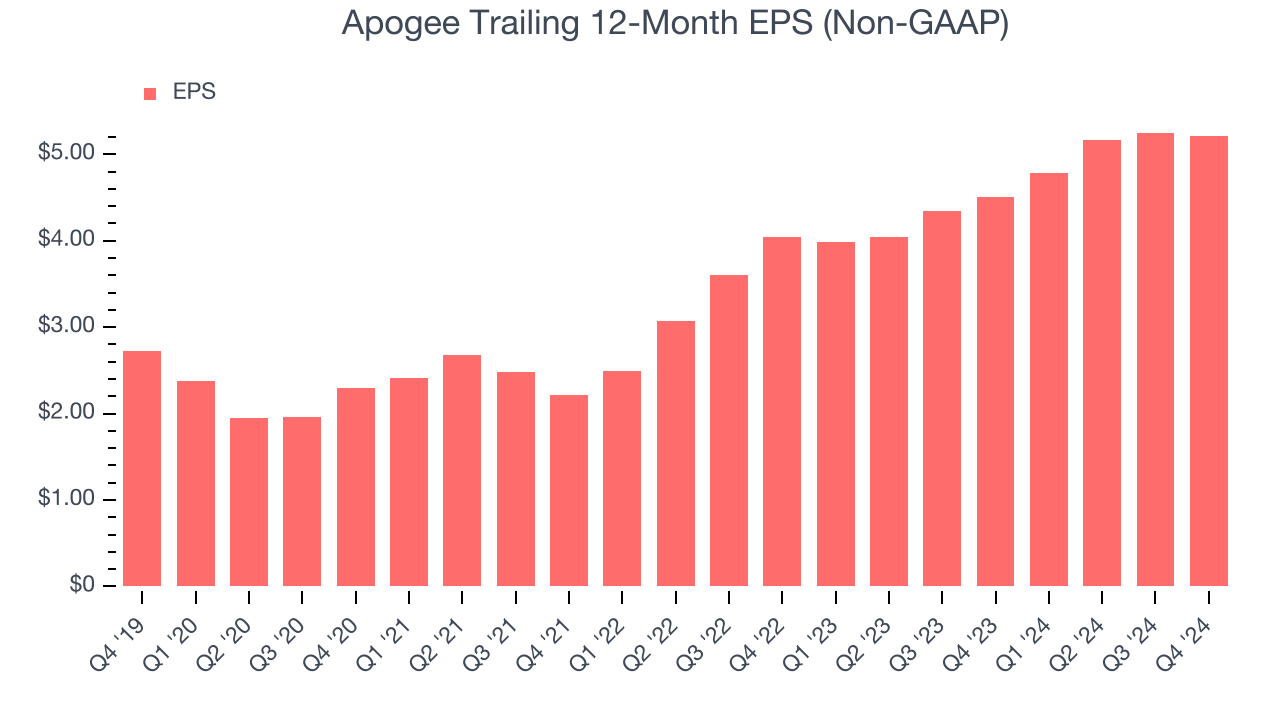
We can take a deeper look into Apogee’s earnings quality to better understand the drivers of its performance. As we mentioned earlier, Apogee’s operating margin declined this quarter but expanded by 4.8 percentage points over the last five years. Its share count also shrank by 18.1%, and these factors together are positive signs for shareholders because improving profitability and share buybacks turbocharge EPS growth relative to revenue growth. 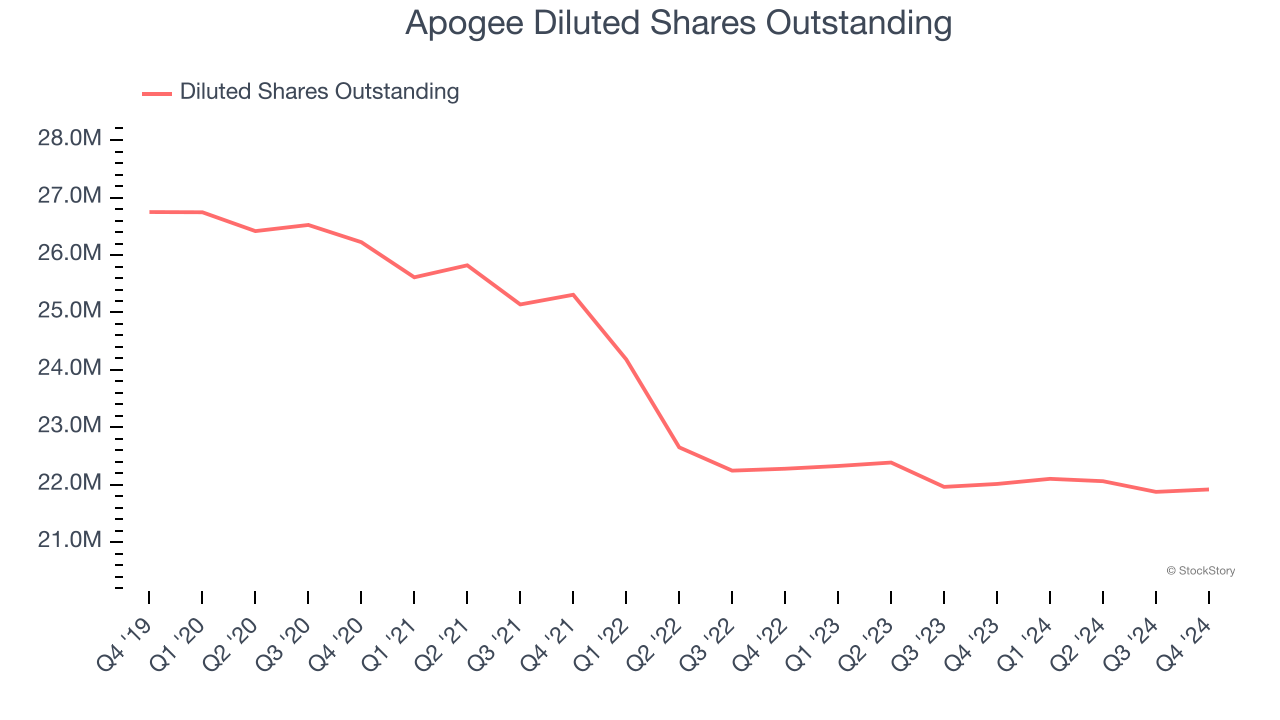
Like with revenue, we analyze EPS over a shorter period to see if we are missing a change in the business.
For Apogee, its two-year annual EPS growth of 13.6% is similar to its five-year trend, implying strong and stable earnings power.In Q4, Apogee reported EPS at $1.19, down from $1.23 in the same quarter last year. Despite falling year on year, this print beat analysts’ estimates by 6.9%. Over the next 12 months, Wall Street expects Apogee’s full-year EPS of $5.21 to shrink by 5.3%.
Key Takeaways from Apogee’s Q4 Results
We enjoyed seeing Apogee exceed analysts’ revenue expectations this quarter. We were also glad its EBITDA outperformed Wall Street’s estimates. On the other hand, its full-year EPS guidance slightly missed. Overall, we think this was a solid quarter, but the guidance seems to be weighing on shares. The stock traded down 1.6% to $69.99 immediately following the results.
Is Apogee an attractive investment opportunity right now? We think that the latest quarter is only one piece of the longer-term business quality puzzle. Quality, when combined with valuation, can help determine if the stock is a buy. We cover that in our actionable full research report which you can read here, it’s free.
